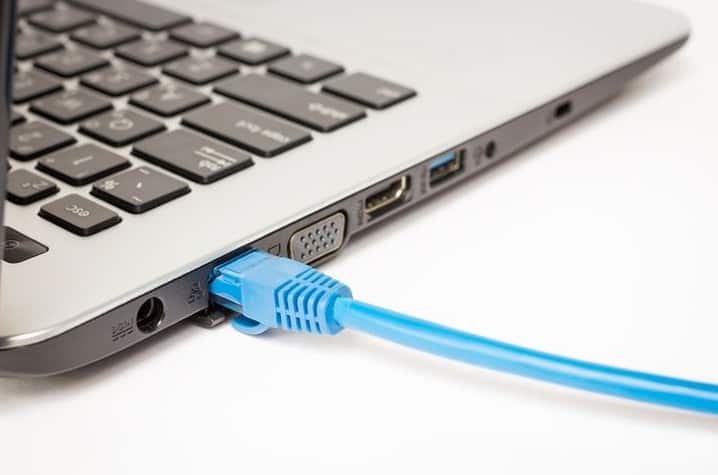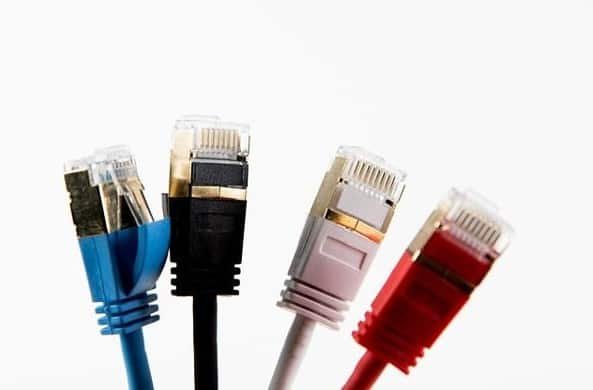A real alternative to Wi-Fi, the Ethernet cable ensures an Internet connection without latency and much faster data transfer. However, network cables do not all offer the same level of performance and are not suitable for all uses. To make the most of the Internet, you should therefore choose your Ethernet cable carefully.
What is an Ethernet cable and what is it used for?
An Ethernet cable is a type of cable that connects multimedia equipment or computer networks to the Internet. It is used in particular to connect a computer, a game console, a Smart TV, and a switch to an internet box. It can also connect two PCs together or a PC to a printer, and broadcast a telephone signal in a house.
Compared to Wi-Fi which can be subject to a network outage, an Ethernet cable offers an optimal continuous connection. It also provides more security since it involves being physically connected to an Internet network.
The RJ45 cable has become the standard for Ethernet cable. It is also known as 8P8C (for 8 positions and 8 contacts). The RJ45 cable is made up of 4 pairs of strands, i.e. 8 wires in total, each of which is spaced one millimeter apart. In each pair, one wire is a solid color and the other striped to allow the current to balance:
- green and white-green striped,
- orange and white-orange striped,
- blue and white-blue striped,
- brown and striped white-brown.
An RJ45 cable looks like a plug with a plastic pin that needs to be pressed to install or remove from an Ethernet port.
Crossover or straight?
Unlike a cord, an RJ45 cable does not have male plugs at each end, but plastic pins with which it can connect two devices together. There are two types of Ethernet cables: crossover and straight. The crossed RJ45 cable allows two receivers to be connected together without going through an internet network. For example, it can connect two PCs together or a PC and a printer. The straight RJ45 cable is much more widespread and used than the crossover RJ45 cable. It can connect multimedia equipment to an RJ45 wall socket or to an internet box.
Monobrin or multibrin?
Ethernet cables are manufactured in two forms: solid and stranded. The single-stranded RJ45 cable is made of a single thick copper wire which makes it rigid and solid. Used mainly for network cabling in the wall or under the floor, it guarantees a better internet connection and more protection against electrical interference. It can carry a signal over a longer distance, which is why it is coveted by business networks.
The multi-stranded RJ45 cable is made of many fine copper strands which make it light, soft, and flexible. It is the most widespread on the market, but also the least expensive. Easier to install at home than a solid cable, it can carry an internet signal over a short distance. It is mainly used to connect peripherals and multimedia equipment such as an internet box, a PC, a game console, or a switch.
With or without shielding?
The shielding of an Ethernet cable makes it possible to limit external magnetic or electromagnetic phenomena as much as possible during data transmissions. These parasites can especially occur when it is adjacent to other electrical sources such as a CPL kit, integrated into a wall, or placed under a floor. The shielding of an RJ cable makes it heavy and stiff, but promises a better communication network. It uses the acronyms UTP, FTP, and STP to indicate its level of resistance to disturbances.
UTP ou U/UTP? (Unshielded / Unshielded Twisted Pair)
This Ethernet cable has no shielding and is only for use with categories 5e, 6, and 6a. It is suitable for indoor home use.
FTP ou F/UTP? (Foiled / Unshielded Twisted Pair)
This RJ45 cable has a light shielding level. The 4 pairs of wires are twisted and wrapped in aluminum foil. It is the most widespread shield on the market and is used with categories 5e, 6, and 6a.
STP ou U/FTP? (Unshielded / Foiled Twisted Pair)
This Ethernet cable is made up of 4 pairs of wires wrapped in aluminum foil, but the sheath is not shielded at all. It is mainly used in areas exposed to electrical interference. It is used with categories 5e, 6, 6a, and 7.
SFTP ou SF/UTP? (Shielded Foiled / Unshielded Twisted Pair)
This RJ45 cable offers the best protection against electromagnetic phenomena. It uses an aluminum screen and a copper braid. It is used with categories 5e, 6, 6a, 7, 8, and 8.1.
Which category of Ethernet cable for which use?
RJ45 cables are divided into categories according to their level of performance and the quality of data transmissions. They are called the word “Cat” followed by a number from 5 to 8. The higher it is, the higher the MHz frequency is too. It is also necessary to take into account the length of an RJ45 cable since it has a direct impact on its efficiency. The longer it is, the worse the performance. An RJ45 cable capable of handling large bandwidths ensures a faster internet connection.
CAT 5e: for home networks
Given its low cost, CAT 5e is the most common Ethernet cable. It offers a maximum throughput of 1 GB/s and can handle a bandwidth of 100 MHz over a maximum length of 100m. It is particularly suitable for an ADSL network, an internet box, and a personal telephone network.
CAT 6: for business networks
CAT 6 Ethernet cable is more expensive than CAT 5e, but above all more efficient. It is also more secure thanks to a separator that isolates the copper wires. Ideal for companies and intranet networks, it offers a maximum speed of 10 GB/s with a bandwidth of 250 MHz over a total length of 55 m.
CAT 6a: for large inter-company networks
The CAT 6a Ethernet cable is shielded, therefore denser and less flexible than Cat 6. If it offers the same speed as its 10 Gb/s friend, it can also handle a higher bandwidth of 500 Mhz and offers an improved length of 100m.
CAT 7: for very high-speed networks
The RJ45 CAT 7 cable is more modern, more efficient, but also more expensive than CAT 6. It offers a maximum speed of 40 Gb/s over 50 m and 100 Gb/s over 15 m. It can also handle a bandwidth of 600 to 1000 MHz. All Cat 7 Ethernet cables have 4 twisted pairs which are individually shielded.
CAT 8: for industrial and tertiary networks
Recent and fully shielded, CAT 8 Ethernet cable is the best alternative to optical fiber. It justifies its high price by a maximum speed of 40 Gb/s, a bandwidth of 2 GHz and a maximum length of 30 m. It is suitable for the most demanding networks, in particular industries and the tertiary sector.


